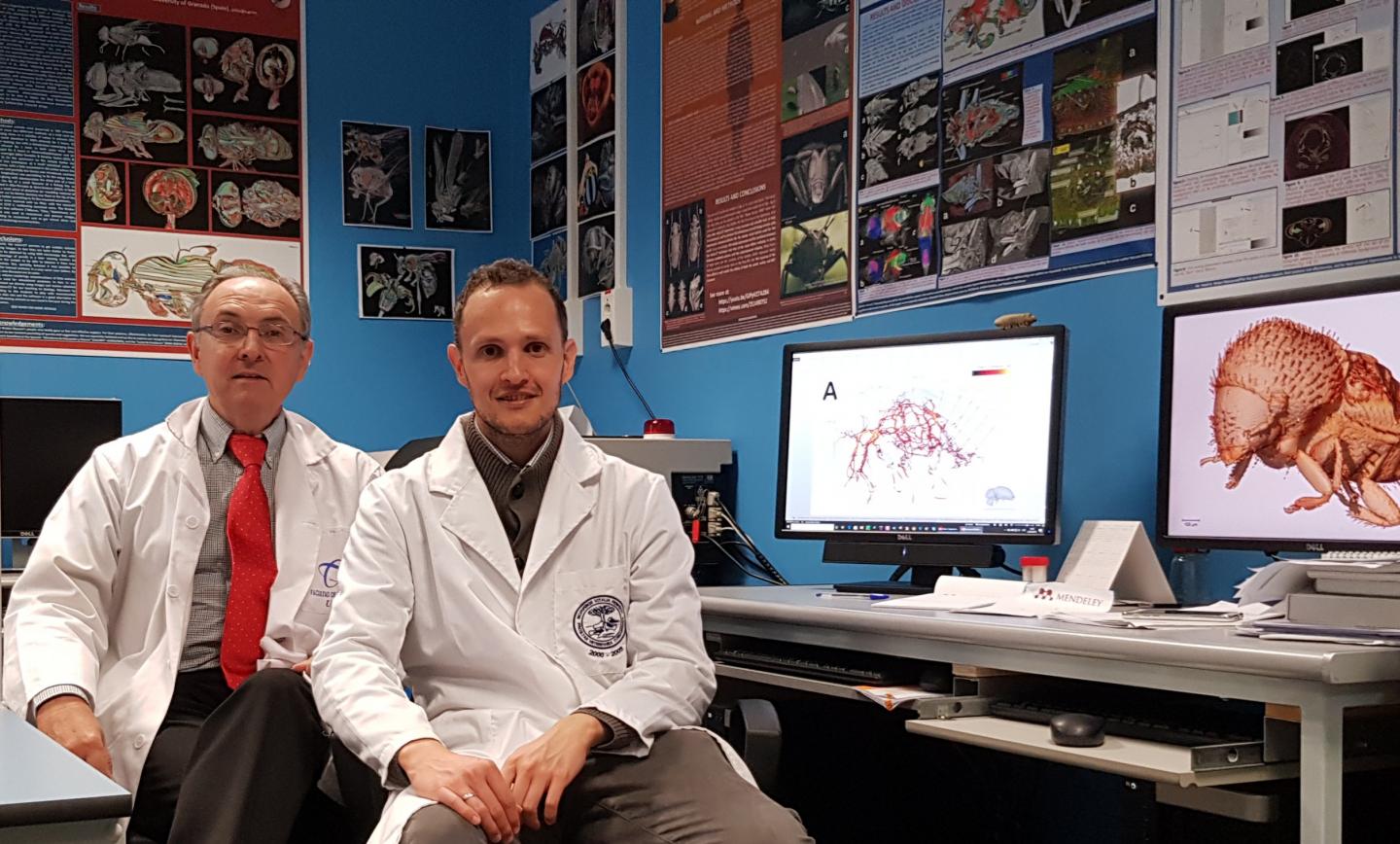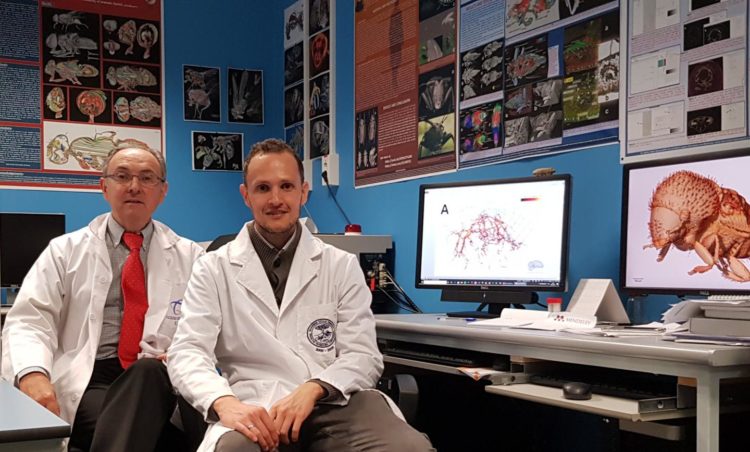Scientists from the University of Granada, thanks to microtomography techniques, reveal secret, and until now unknown, aspects of tunnel construction strategies, and how to exploit the fruit, in addition to the internal structures of a tiny beetle

Credit: UGR Divulga
Scientists from the University of Granada (UGR), belonging to the Department of Zoology, have provided new data on Hypothenemus hampei, a tiny beetle of just over a millimeter in size that is known as ‘the coffee berry borer’, because it attacks coffee berries digging tunnels with cameras in which they lay eggs.
This insect is responsible for the greatest pests that exist in coffee, and to date its hidden life within coffee berries was little known. The Microtomography Unit of the Department of Zoology of the University of Granada, which is led by Professor Javier Alba-Tercedor, has revealed secret, and until now unknown, aspects of tunnel construction strategies, and how to exploit the fruit. They have also been able to study in detail the structures and organs of this small insect.
After suffering a metamorphosis, the larvae of this beetle become pupae that give rise to adults of both sexes. The males copulate with their sisters, who once fertilized leave the fruit and spread the plague. To avoid the toxicity of coffee, interestingly, these small insects have symbiont microorganisms in their digestive tract that degrade caffeine.
Thanks to the dissemination of the spectacular achievements made with microtomography, Dr. Fernando Vega, a well-known scientist from the Department of Agriculture in Maryland (United States) who has been working with this pest for many years, contacted the University of Granada for collaboration. Thus, as part of the doctoral thesis of Ignacio Alba-Alejandre, the UGR researchers have obtained new and revealing data on this tiny beetle species.
Females generally drill a single entrance tunnel. The microtomography has revealed that the entrance tunnel does not have a rectilinear trajectory, but is zigzag, and the founder female is placed plugging the entrance with the back of the body. This hinders the rapid entry of potential enemies.
The same defensive pattern as at the gates of the Alhambra
“Interestingly, this strategy has been used throughout history to protect fortresses and castles. For example, the entrance doors of the Alhambra in Granada follow this same pattern”, says Alba-Tercedor. In addition, the larvae do not deplete the fruit by eating and drilling new random tunnels, but instead follow an organized pattern by first depleting one side of the coffee bean, and always starting at the outermost part, and then the other grain of the fruit. If it is difficult to imagine how such a small animal has developed such complex construction behavior and mastery throughout evolution, it is even more astonishing to contemplate the complex internal anatomy with the different organs. “pay attention, for instance, existing sexual differences, such as those that exist in the configuration of the digestive system according to sex: the male, who is smaller, has a greater number of convolutions in his digestive tract so that, maintaining the length of absorption of tubes, the digestive tract can fit in a short-smaller body than the female, “says the UGR professor.
In addition, as the life of the males is less risky and complex (since they do not leave the fruit of the coffee cherry in which they were born), it has reduced wings (and therefore lack the necessary muscles) and their brains are smaller and differently shaped in relation to females.
The insects have a respiratory system, called the tracheal system, composed of a complex network of tubes that, starting from small external holes, are branching into smaller and smaller tubes, reaching diameters of just one thousandth of a millimeter, in order to carry Oxygen to each cell. Given its small size, it is difficult to be able to highlight this complicated network of tubes either by classical dissections techniques, or even by using microtomographic techniques.
Despite this, the research team at the University of Granada has been able to develop a technique that needs to scan the insects immediately after immobilizing them (sacrificing or anesthetizing them) and then rebuilding the air-filled space inside the tracheal tubes
The anatomy of an insect
Thanks to this, scientists have been able to reconstruct the tracheal system of these insects for the first time and describe and name many of the branches that for the layman would be a circulatory system. The total length of tubes is 73 times the length of the animal. If we transpose this to a human scale, then a 175 cm long insect (the average height for American males47) would have 123 m of tracheal tubes (longer than a football or soccer field). The circulatory system of insects is barely reduced to a heart that pumps hemolymph (blood) and from which an anterior and a posterior aorta (which has also been studied).
“The novelty of the study lies in being the first time that with microtomography the entire anatomy of an insect is reconstructed, being the smallest studied with this technique, so this achievement constitutes itself a great scientific advance”, highlights the UGR researcher. But in addition, the images, videos and 3D models obtained by scientists, which can be viewed on any mobile device (smartphones / tablets), represent a great help in teaching entomology and of interest to the general public.
These findings have been published in recent months in different works in the prestigious journal Scientific Reports of Nature.
This collaboration of the UGR researchers is not the first one they get thanks to the scientific dissemination of their work. Thus, his articles on honey bees inspired in 2019 to create works of art for a humanoid robot, named Ai-Da developed in Oxford, and Professor Alba-Tercedor also participated in the scanning of beetles that appear in the film ‘Blade Runner 2049’, which in 2017 won the Oscar for the best visual effects
###
Media Contact
Javier Alba Teredor
[email protected]
34-958-818-018
Original Source
https:/





